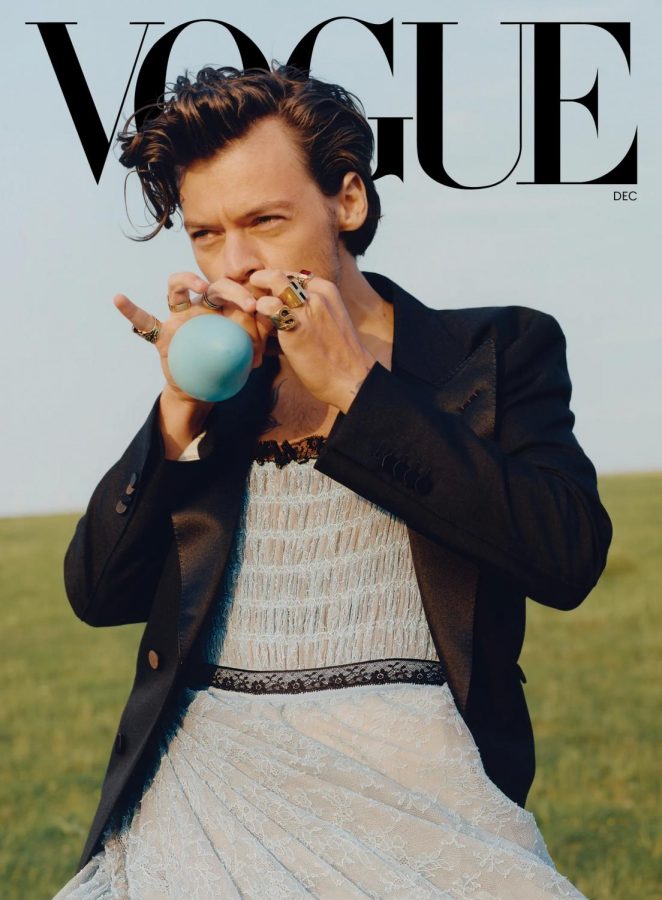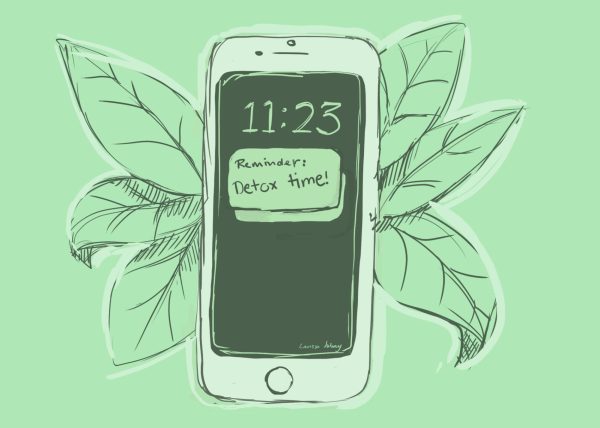Vogue and Harry Styles
On the Frontier of Combatting Toxic Masculinity
British singer-songwriter Harry Styles has made history, and it doesn’t have anything to do with his music. Recently, he became the first ever solo male model to appear on the cover of Vogue. On it, he was wearing a lilac blue Gucci ball gown, topped with a tuxedo jacket. Instead of being considered an enormous accomplishment, many conservative personalities and gender conformists used social media to express their disagreement and antipathy towards Styles’ unusual or iconoclastic fashion choices. These responses sparked much controversy between his supporters and adversaries. Times are changing, and people have been starting to feel more open in expressing their genders and sexualities; the constraining boundaries between feminine and masculine are starting to fade. Harry Styles took his stance by appearing on the cover of this contemporary magazine wearing a dress. So what is the meaning behind his appearance on Vogue and what do the reactions of the public say about our modern society?
One of the most vocal individuals on the subject is conservative American author Candace Owens. Owens has very strong and primitive views about how society should work. Her conservative background and ideology were the inspiration behind her one and only book “Blackout: How Black America Can Make It’s Second Escape From the Democrat Plantation.” Along with her traditionalist friend, Ben Shapiro, she criticised and scolded Styles for wearing a dress and embracing his feminine side. She also took to berating the rest of society for allowing this “outright attack” to occur. Owens believes that without powerful, authentic, macho men, society won’t be able to sustain itself. She believes gender roles and fashion should be rigid and unchanging. She believes that instead of letting people express and embrace themselves through the way they dress and act, the most important thing on the agenda is to “bring back manly men.”
Shortly after her first tweet aimed at Harry Styles, fans and onlookers all around the world started pointing out that men wearing fashion that we would consider “feminine” has been done for centuries. Men wore jewelry in the 16th century, kilts have been and continue to be a big part of Scottish culture, gladiators wore dresses, and so did Hercules and Zeus. Even Jesus wore a dress! Yet somehow, a man wearing a dress in today’s society is considered “wrong,” and seeing a boy with painted nails on the street is unspeakable. This is where the concept of toxic masculinity comes into play.
Toxic masculinity is a limited and repressive definition of manhood. Is designates manhood as characterized by abuse, sex, rank, and hostility. “It’s the cultural ideal of manliness, where strength is everything while emotions are a weakness.” In this context, we can say that Owens’ ideology of what men should be is toxic. Masculinity alone does not make a man. Men shouldn’t only be characterized as strong and manly. Men showing emotions shouldn’t be considered a weakness or fault. Men should be able to express themselves in society by wearing what they want, even if it isn’t considered masculine. Although Owens, Shapiro and many others have been continuously putting down those who are just fighting for freedom of expression, much change and many good things have come from Styles appearing on the Vogue cover.
Styles has inspired many people all over the world to dwell upon their ideas of gender fluidity in fashion. Boys in many different countries started showing up to school in dresses to support the singer songwriter and tear down the toxic masculinity in their communities. In response to backlash, Styles posted a picture of himself in a pleated blue suit with the caption “Bring back manly men,” obviously mocking Owens’ previous comments. While starting a new fashion revolution, Styles has also encouraged his fans and people all around the world to embrace themselves and who they are in a new way: fashion. “To not wear something because it’s females’ clothing, you shut out a whole world of great clothes,” he said. “And I think what’s exciting about right now is you can wear what you like. It doesn’t have to be X or Y. Those lines are becoming more and more blurred.” I couldn’t have said it better myself.
Change is coming and what better time than now is it to start learning how to embrace it? Maybe instead of tearing others down and berating them for who they are and what they wear, we should take some advice from one of Styles’ songs and finally start to “Treat People With Kindness.”

Taya's position in the Advocate reflects her love for journalism. She is able to write fiery passionate articles like Kid Cudi's Gender Bending Performance while...







